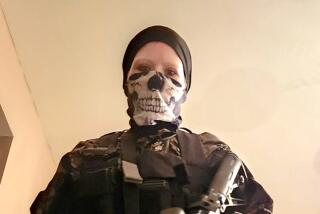U.S. Suspects Kadafi of Orchestrating Wave of Terrorist Attacks
- Share via
WASHINGTON — U.S. officials suspect that Libyan leader Moammar Kadafi, using the cover of Palestinian and Japanese terrorist groups, is a major instigator of a sudden resurgence in terrorist attacks on American and Western targets in the Middle East and elsewhere.
“The general assessment here is that the Libyans are becoming more active,” said L. Paul Bremer III, the State Department’s chief anti-terrorist expert.
The main suspected Libyan surrogate today appears to be Sabri Banna, the most notorious Palestinian terrorist and better known as Abu Nidal, U.S. anti-terrorist officials said. After being expelled from Syria last summer, he has set up his headquarters in Tripoli, the Libyan capital.
The officials also strongly suspect that Kadafi has enlisted the services of the Japanese Red Army terrorist organization to carry out operations against U.S. and other Western targets.
These officials conceded that the evidence of a direct connection between Libya and the two terrorist groups is largely circumstantial and that there is still no proof, or “smoking gun,” to show that Kadafi is masterminding the new outbreak of terrorist incidents. There is debate, and no agreement, in the Reagan Administration over the extent of Kadafi’s role, according to one official.
But U.S. intelligence agencies have concluded that Abu Nidal and Red Army operatives have been responsible for a number of recent terrorist incidents around the world. Some anti-terrorist officials, such as Bremer, believe the incidents had Kadafi’s blessing, if not his direction, because they coincided so closely with the second anniversary of the U.S. air raid on Kadafi’s living quarters and other targets in Tripoli in April, 1986.
The U.S. action was in retaliation for the bombing of a West Berlin disco earlier that month that killed a U.S. army sergeant.
Terrorist incidents this year during the April 10-15 period included four attacks on U.S. Information Agency buildings in three Latin American countries and a bomb attack on the USO club in Naples, Italy.
U.S. anti-terrorist officials said there is still no hard evidence of Libyan involvement in the attacks in Costa Rica, Colombia and Peru but they remain suspicious because of the timing.
However, the officials said there is considerable evidence that the Japanese Red Army was responsible for the Naples bombing April 14 in which five people, including a U.S. servicewoman, were killed, and 15 others, including four U.S. sailors, injured. A Japanese Red Army member, Junzo Okudaira, is wanted in connection with the incident, which Italian authorities also suspect was in retaliation for the U.S. raid on Tripoli because of the coincidence of dates.
Another suspected Japanese Red Army member, Yu Kikumura, was arrested April 12 on the New Jersey Turnpike after he was found carrying three homemade bombs in his car. Police have not been able to determine what he intended to do with the bombs.
The spate of terrorist incidents has not let up.
On May 10, a bomb went off at the Citibank office in New Delhi. U.S. officials believe this also was a Japanese Red Army operation.
On May 15 in Khartoum, Sudan, three Arabs with Lebanese passports attacked the Acropol Hotel and British Club with machine guns and grenades, killing a British family of four and three others, and injuring 21, including two Americans. The three Arabs confessed to police that they belong to the Abu Nidal organization, according to Sudanese press reports.
Signs of Kadafi’s new activism in terrorist and subversive activities go back at least to late fall, U.S. officials said. French authorities in early November intercepted a ship carrying 150 tons of Libyan-provided arms, including surface-to-air missiles, bound for the Irish Republican Army in Northern Ireland. At the time, State Department spokesman Charles Redman called the haul “the largest terrorist arms shipment ever intercepted.”
More to Read
Sign up for Essential California
The most important California stories and recommendations in your inbox every morning.
You may occasionally receive promotional content from the Los Angeles Times.













